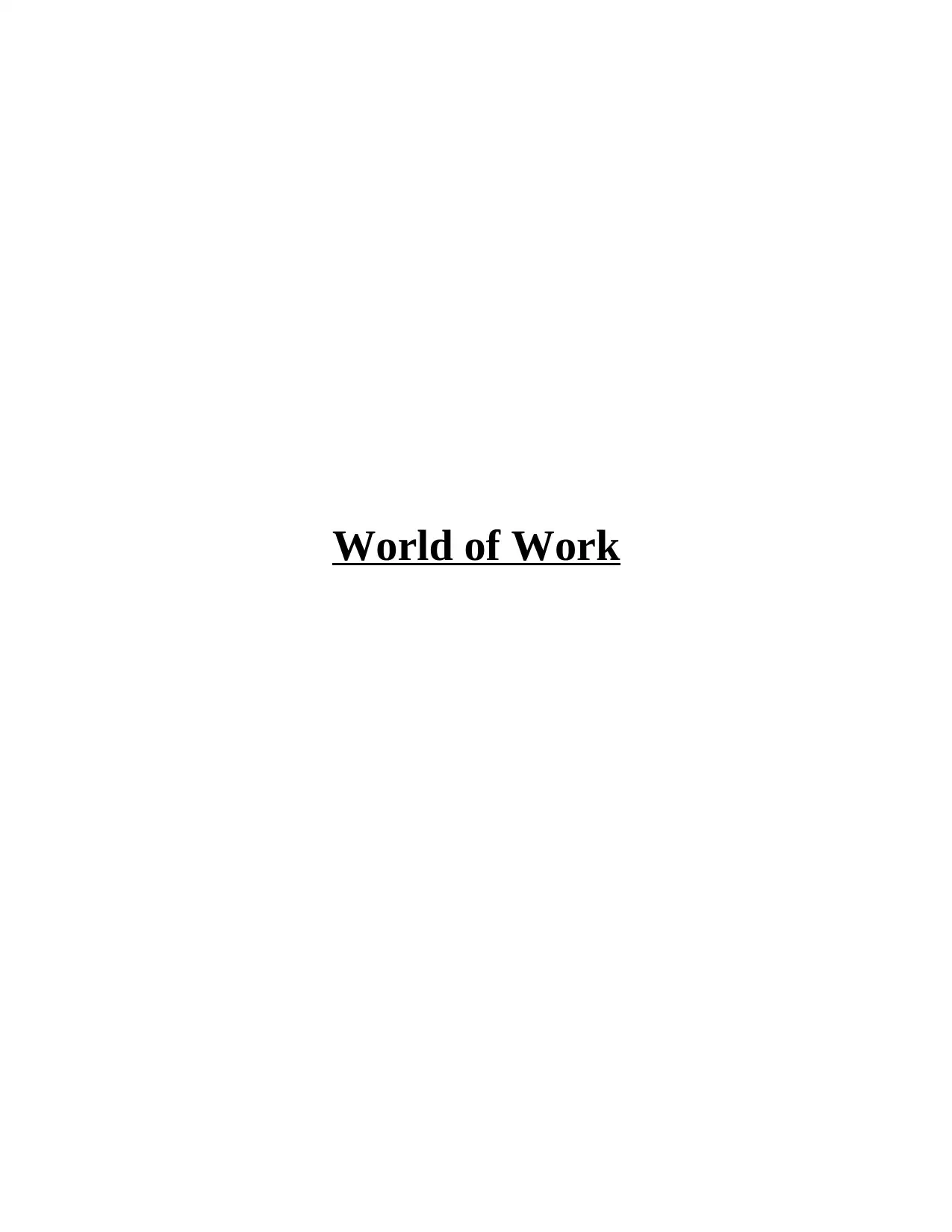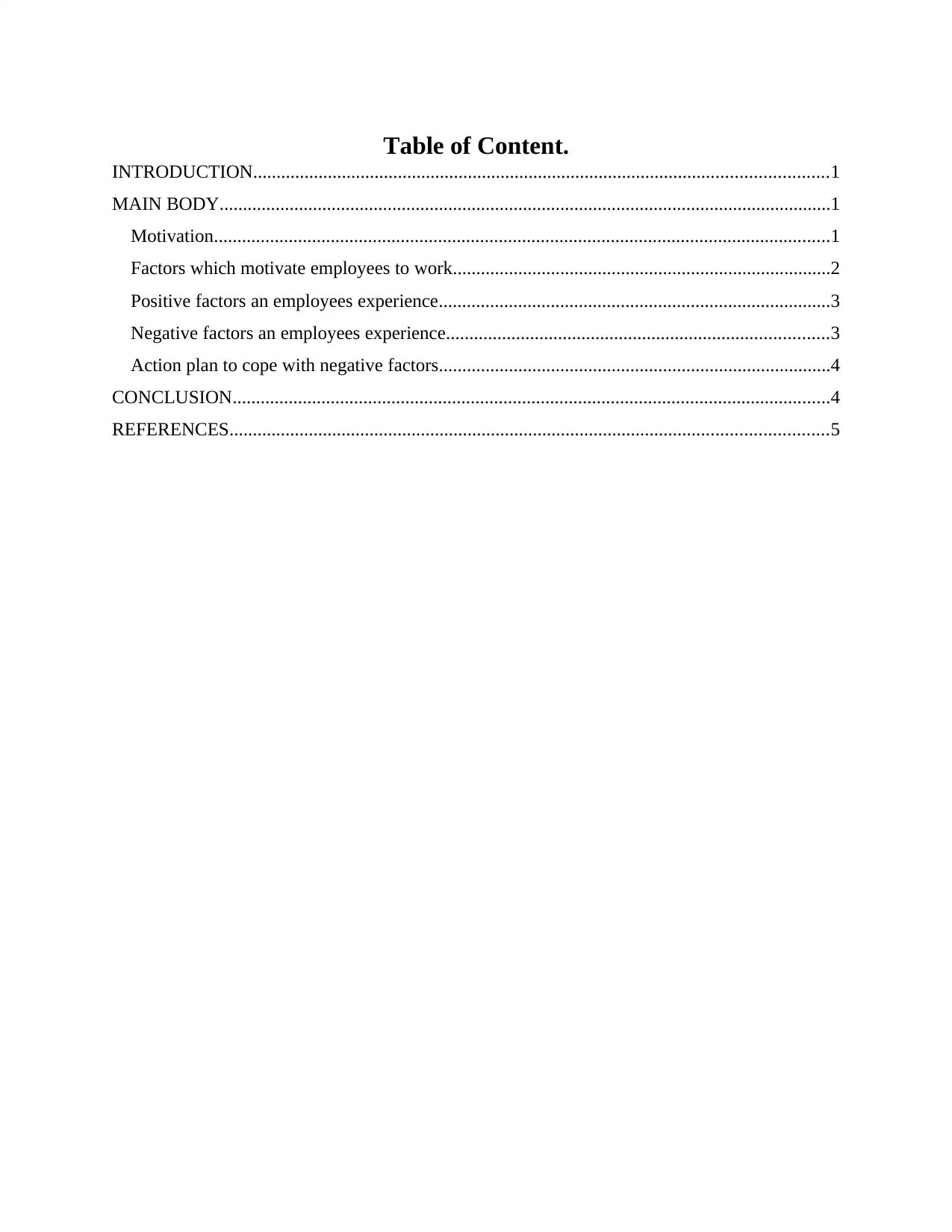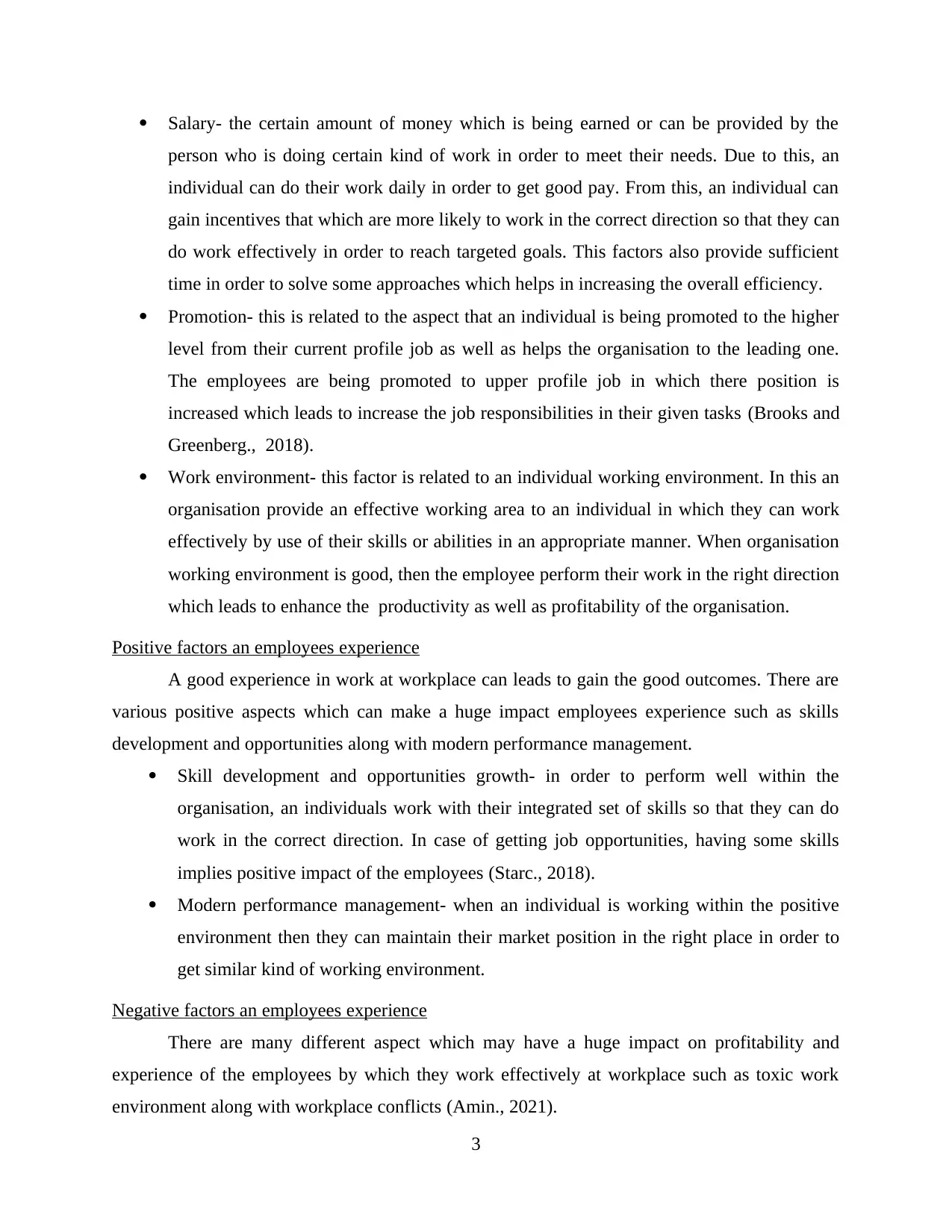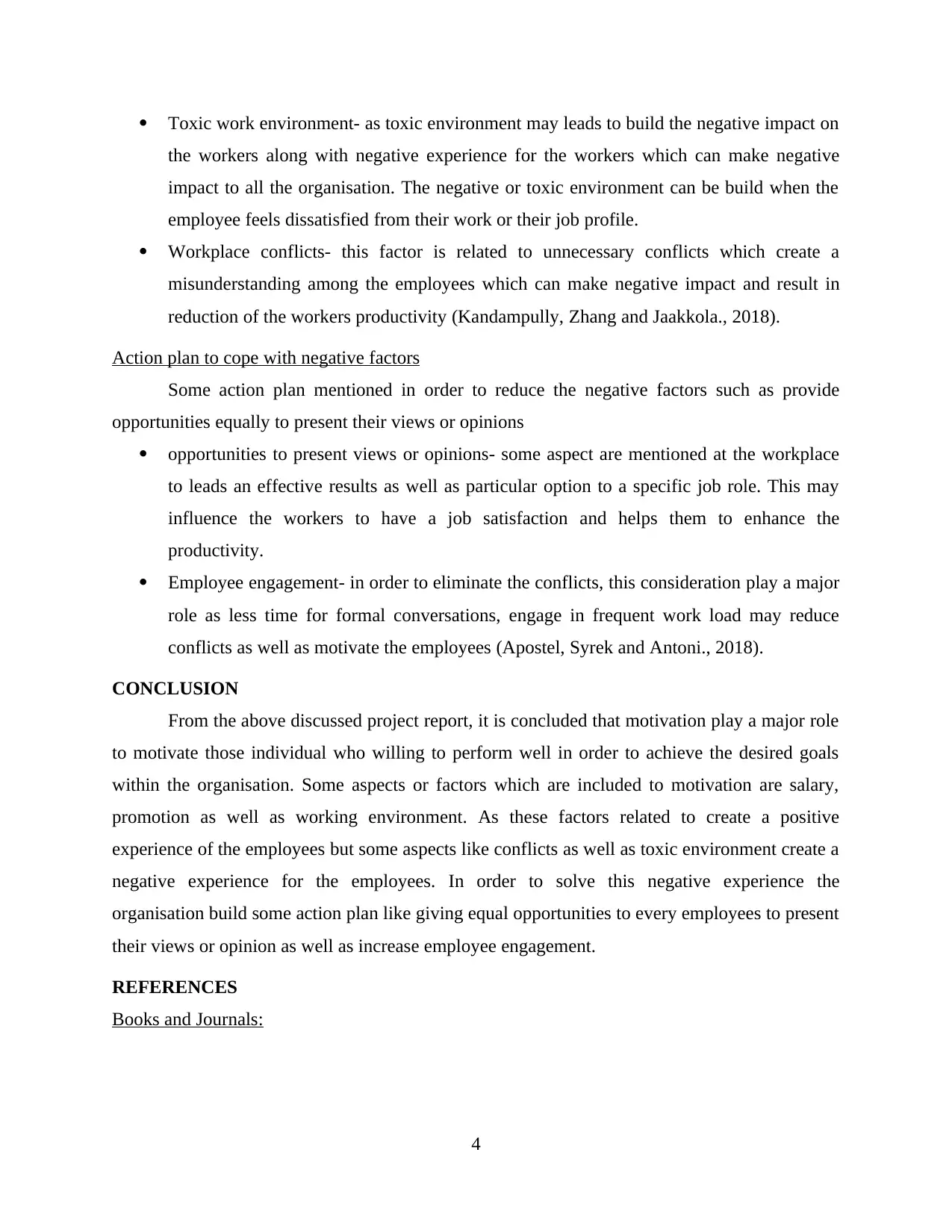A Comprehensive Report on Employee Motivation in the Workplace
VerifiedAdded on 2023/06/08
|7
|2023
|208
Report
AI Summary
This report provides a comprehensive analysis of employee motivation within the workplace. It begins with an introduction to the concept of motivation, emphasizing its role in guiding and maintaining goal-oriented behaviors. The main body delves into various motivational theories, notably Maslow's hierarchy of needs, and differentiates between intrinsic and extrinsic motivation. The report then identifies factors that motivate employees, such as salary, promotion, and work environment, alongside positive experiences like skill development and modern performance management. Conversely, it examines negative factors, including toxic work environments and workplace conflicts. The report concludes by proposing an action plan to mitigate negative experiences, such as providing opportunities for employees to share their views and increasing employee engagement, offering strategies to improve productivity and job satisfaction. The report also includes a detailed list of references.

World of Work
Paraphrase This Document
Need a fresh take? Get an instant paraphrase of this document with our AI Paraphraser

Table of Content.
INTRODUCTION...........................................................................................................................1
MAIN BODY...................................................................................................................................1
Motivation....................................................................................................................................1
Factors which motivate employees to work.................................................................................2
Positive factors an employees experience....................................................................................3
Negative factors an employees experience..................................................................................3
Action plan to cope with negative factors....................................................................................4
CONCLUSION................................................................................................................................4
REFERENCES................................................................................................................................5
INTRODUCTION...........................................................................................................................1
MAIN BODY...................................................................................................................................1
Motivation....................................................................................................................................1
Factors which motivate employees to work.................................................................................2
Positive factors an employees experience....................................................................................3
Negative factors an employees experience..................................................................................3
Action plan to cope with negative factors....................................................................................4
CONCLUSION................................................................................................................................4
REFERENCES................................................................................................................................5

INTRODUCTION
Motivation is the process which could initiates, guide as well as maintain the goal
oriented behaviours. Motivation includes some biological, emotional, social as well as cognitive
forces which activate an individuals behaviours. Motivation could maintained the overall
working of an employee, due to which company can gain or achieve their pre- defined goals in a
well defined manner. When an individual is working within the organisation it means they learn
or get to know the working environment along with that the individual develops certain skills
which could helps them for future growth. There are various certain reason or approaches due to
which could make people to work. Motivation is one of the most important aspect which have
have direct impact or emphasis on the overall working of the individuals as motivation may
influence the people to feel motivated towards the work. Therefore, the project report give the
brief knowledge about the theories of motivation along with some positive or negative aspect of
motivation. Apart from this, the project report analyse some strategies in order to reduce the
negative experience.
MAIN BODY
Motivation
Motivation is a process which includes certain step which is followed by the people in
order to do effective or efficient work at the workplace. Motivation includes various factor such
as emotional , biological along with some social aspects that leads to influence the overall
behaviour of the employee.
Some of the different theories of the motivation are discussed such as Maslow's hierarchy of
needs.
Maslow's hierarchy of needs
this theory was presented by Abraham Maslow, it is one of the most known or influential
theory to motivate the people at the workplace. This theory is basically based on the five aspects
of the human needs which are related or are arranged in hierarchy.
Physiological needs- this includes the most basic needs of the individual which are
having certain things such as air, water, food, clothing, shelter and many more things. In
case, these needs were not fulfilled to an individuals then they cannot live a better life
(Maryani, Entang and Tukiran., 2021).
1
Motivation is the process which could initiates, guide as well as maintain the goal
oriented behaviours. Motivation includes some biological, emotional, social as well as cognitive
forces which activate an individuals behaviours. Motivation could maintained the overall
working of an employee, due to which company can gain or achieve their pre- defined goals in a
well defined manner. When an individual is working within the organisation it means they learn
or get to know the working environment along with that the individual develops certain skills
which could helps them for future growth. There are various certain reason or approaches due to
which could make people to work. Motivation is one of the most important aspect which have
have direct impact or emphasis on the overall working of the individuals as motivation may
influence the people to feel motivated towards the work. Therefore, the project report give the
brief knowledge about the theories of motivation along with some positive or negative aspect of
motivation. Apart from this, the project report analyse some strategies in order to reduce the
negative experience.
MAIN BODY
Motivation
Motivation is a process which includes certain step which is followed by the people in
order to do effective or efficient work at the workplace. Motivation includes various factor such
as emotional , biological along with some social aspects that leads to influence the overall
behaviour of the employee.
Some of the different theories of the motivation are discussed such as Maslow's hierarchy of
needs.
Maslow's hierarchy of needs
this theory was presented by Abraham Maslow, it is one of the most known or influential
theory to motivate the people at the workplace. This theory is basically based on the five aspects
of the human needs which are related or are arranged in hierarchy.
Physiological needs- this includes the most basic needs of the individual which are
having certain things such as air, water, food, clothing, shelter and many more things. In
case, these needs were not fulfilled to an individuals then they cannot live a better life
(Maryani, Entang and Tukiran., 2021).
1
⊘ This is a preview!⊘
Do you want full access?
Subscribe today to unlock all pages.

Trusted by 1+ million students worldwide

Safety needs- when the physiological needs of an individuals are meet, then the persons
want to gather the experience, control as well as start predicting the human life needs
which can be meet by the society or by the family. This will assist the individual to have
a free mind set in order to do the work in accurate manner.
Belonging or love needs- this needs is arise by an individuals when the person having the
certain consideration or assumptions for their private relationships along with the part of
certain groups. There are various factors which are required in case of meet the needs of
the peoples such as trust, friendship, value, belief and many more things. When these
needs are satisfied then the individuals feel motivated to do the work properly (Clipa.,
2018).
Self- esteem needs- this aspect is related to the two categories, one categories is self-
esteem for the individual and the other categories is the dignity which can be maintained
by achieve the certain achievement. This is related to the recognition as well as the
respect of an individual. Therefore, this needs is satisfied by doing some work in order to
get respect, prestige from the other person or from the reputed person.
Self-actualization needs- this is the most highest level need which involves the person
actual capabilities which will assist them to grow along with gain some experience. This
needs provides the helps to examine the better accomplishment so that an individual can
live perfect or good life.
There are two type of motivation which are mentioned below such as Intrinsic as well as
extrinsic.
Intrinsic- this type of motivation is related to the capabilities of an individuals. As they
are being rewarded when they achieve some goals by using the appropriate methods. The
rewards may includes receiving appropriate feed-backs from the others.
Extrinsic- this types of motivation is related to the exhibition of certain tasks, due to
which the people can get some outside effect such as receiving the rewards rather than
receiving punishments, avoiding punishments. As this will assist in some cases which
contains some rewards or some benefits (Iwaniec., 2019).
Factors which motivate employees to work
There are various factors which motivates the employee to work at workplace such as
salary, promotion as well as work environment.
2
want to gather the experience, control as well as start predicting the human life needs
which can be meet by the society or by the family. This will assist the individual to have
a free mind set in order to do the work in accurate manner.
Belonging or love needs- this needs is arise by an individuals when the person having the
certain consideration or assumptions for their private relationships along with the part of
certain groups. There are various factors which are required in case of meet the needs of
the peoples such as trust, friendship, value, belief and many more things. When these
needs are satisfied then the individuals feel motivated to do the work properly (Clipa.,
2018).
Self- esteem needs- this aspect is related to the two categories, one categories is self-
esteem for the individual and the other categories is the dignity which can be maintained
by achieve the certain achievement. This is related to the recognition as well as the
respect of an individual. Therefore, this needs is satisfied by doing some work in order to
get respect, prestige from the other person or from the reputed person.
Self-actualization needs- this is the most highest level need which involves the person
actual capabilities which will assist them to grow along with gain some experience. This
needs provides the helps to examine the better accomplishment so that an individual can
live perfect or good life.
There are two type of motivation which are mentioned below such as Intrinsic as well as
extrinsic.
Intrinsic- this type of motivation is related to the capabilities of an individuals. As they
are being rewarded when they achieve some goals by using the appropriate methods. The
rewards may includes receiving appropriate feed-backs from the others.
Extrinsic- this types of motivation is related to the exhibition of certain tasks, due to
which the people can get some outside effect such as receiving the rewards rather than
receiving punishments, avoiding punishments. As this will assist in some cases which
contains some rewards or some benefits (Iwaniec., 2019).
Factors which motivate employees to work
There are various factors which motivates the employee to work at workplace such as
salary, promotion as well as work environment.
2
Paraphrase This Document
Need a fresh take? Get an instant paraphrase of this document with our AI Paraphraser

Salary- the certain amount of money which is being earned or can be provided by the
person who is doing certain kind of work in order to meet their needs. Due to this, an
individual can do their work daily in order to get good pay. From this, an individual can
gain incentives that which are more likely to work in the correct direction so that they can
do work effectively in order to reach targeted goals. This factors also provide sufficient
time in order to solve some approaches which helps in increasing the overall efficiency.
Promotion- this is related to the aspect that an individual is being promoted to the higher
level from their current profile job as well as helps the organisation to the leading one.
The employees are being promoted to upper profile job in which there position is
increased which leads to increase the job responsibilities in their given tasks (Brooks and
Greenberg., 2018).
Work environment- this factor is related to an individual working environment. In this an
organisation provide an effective working area to an individual in which they can work
effectively by use of their skills or abilities in an appropriate manner. When organisation
working environment is good, then the employee perform their work in the right direction
which leads to enhance the productivity as well as profitability of the organisation.
Positive factors an employees experience
A good experience in work at workplace can leads to gain the good outcomes. There are
various positive aspects which can make a huge impact employees experience such as skills
development and opportunities along with modern performance management.
Skill development and opportunities growth- in order to perform well within the
organisation, an individuals work with their integrated set of skills so that they can do
work in the correct direction. In case of getting job opportunities, having some skills
implies positive impact of the employees (Starc., 2018).
Modern performance management- when an individual is working within the positive
environment then they can maintain their market position in the right place in order to
get similar kind of working environment.
Negative factors an employees experience
There are many different aspect which may have a huge impact on profitability and
experience of the employees by which they work effectively at workplace such as toxic work
environment along with workplace conflicts (Amin., 2021).
3
person who is doing certain kind of work in order to meet their needs. Due to this, an
individual can do their work daily in order to get good pay. From this, an individual can
gain incentives that which are more likely to work in the correct direction so that they can
do work effectively in order to reach targeted goals. This factors also provide sufficient
time in order to solve some approaches which helps in increasing the overall efficiency.
Promotion- this is related to the aspect that an individual is being promoted to the higher
level from their current profile job as well as helps the organisation to the leading one.
The employees are being promoted to upper profile job in which there position is
increased which leads to increase the job responsibilities in their given tasks (Brooks and
Greenberg., 2018).
Work environment- this factor is related to an individual working environment. In this an
organisation provide an effective working area to an individual in which they can work
effectively by use of their skills or abilities in an appropriate manner. When organisation
working environment is good, then the employee perform their work in the right direction
which leads to enhance the productivity as well as profitability of the organisation.
Positive factors an employees experience
A good experience in work at workplace can leads to gain the good outcomes. There are
various positive aspects which can make a huge impact employees experience such as skills
development and opportunities along with modern performance management.
Skill development and opportunities growth- in order to perform well within the
organisation, an individuals work with their integrated set of skills so that they can do
work in the correct direction. In case of getting job opportunities, having some skills
implies positive impact of the employees (Starc., 2018).
Modern performance management- when an individual is working within the positive
environment then they can maintain their market position in the right place in order to
get similar kind of working environment.
Negative factors an employees experience
There are many different aspect which may have a huge impact on profitability and
experience of the employees by which they work effectively at workplace such as toxic work
environment along with workplace conflicts (Amin., 2021).
3

Toxic work environment- as toxic environment may leads to build the negative impact on
the workers along with negative experience for the workers which can make negative
impact to all the organisation. The negative or toxic environment can be build when the
employee feels dissatisfied from their work or their job profile.
Workplace conflicts- this factor is related to unnecessary conflicts which create a
misunderstanding among the employees which can make negative impact and result in
reduction of the workers productivity (Kandampully, Zhang and Jaakkola., 2018).
Action plan to cope with negative factors
Some action plan mentioned in order to reduce the negative factors such as provide
opportunities equally to present their views or opinions
opportunities to present views or opinions- some aspect are mentioned at the workplace
to leads an effective results as well as particular option to a specific job role. This may
influence the workers to have a job satisfaction and helps them to enhance the
productivity.
Employee engagement- in order to eliminate the conflicts, this consideration play a major
role as less time for formal conversations, engage in frequent work load may reduce
conflicts as well as motivate the employees (Apostel, Syrek and Antoni., 2018).
CONCLUSION
From the above discussed project report, it is concluded that motivation play a major role
to motivate those individual who willing to perform well in order to achieve the desired goals
within the organisation. Some aspects or factors which are included to motivation are salary,
promotion as well as working environment. As these factors related to create a positive
experience of the employees but some aspects like conflicts as well as toxic environment create a
negative experience for the employees. In order to solve this negative experience the
organisation build some action plan like giving equal opportunities to every employees to present
their views or opinion as well as increase employee engagement.
REFERENCES
Books and Journals:
4
the workers along with negative experience for the workers which can make negative
impact to all the organisation. The negative or toxic environment can be build when the
employee feels dissatisfied from their work or their job profile.
Workplace conflicts- this factor is related to unnecessary conflicts which create a
misunderstanding among the employees which can make negative impact and result in
reduction of the workers productivity (Kandampully, Zhang and Jaakkola., 2018).
Action plan to cope with negative factors
Some action plan mentioned in order to reduce the negative factors such as provide
opportunities equally to present their views or opinions
opportunities to present views or opinions- some aspect are mentioned at the workplace
to leads an effective results as well as particular option to a specific job role. This may
influence the workers to have a job satisfaction and helps them to enhance the
productivity.
Employee engagement- in order to eliminate the conflicts, this consideration play a major
role as less time for formal conversations, engage in frequent work load may reduce
conflicts as well as motivate the employees (Apostel, Syrek and Antoni., 2018).
CONCLUSION
From the above discussed project report, it is concluded that motivation play a major role
to motivate those individual who willing to perform well in order to achieve the desired goals
within the organisation. Some aspects or factors which are included to motivation are salary,
promotion as well as working environment. As these factors related to create a positive
experience of the employees but some aspects like conflicts as well as toxic environment create a
negative experience for the employees. In order to solve this negative experience the
organisation build some action plan like giving equal opportunities to every employees to present
their views or opinion as well as increase employee engagement.
REFERENCES
Books and Journals:
4
⊘ This is a preview!⊘
Do you want full access?
Subscribe today to unlock all pages.

Trusted by 1+ million students worldwide

Amin, F.A.B.M., 2021. A Review Of The Job Satisfaction Theory For Special Education
Perspective. Turkish Journal of Computer and Mathematics Education
(TURCOMAT), 12(11), pp.5224-5228.
Apostel, E., Syrek, C.J. and Antoni, C.H., 2018. Turnover intention as a response to illegitimate
tasks: The moderating role of appreciative leadership. International Journal of Stress
Management, 25(3), p.234.
Brooks, S.K. and Greenberg, N., 2018. Non-deployment factors affecting psychological
wellbeing in military personnel: literature review. Journal of Mental Health, 27(1),
pp.80-90.
Clipa, O., 2018. Relations of Style of Leadership and Achievement Motivation for
Teacher. Romanian Journal for Multidimensional Education/Revista Romaneasca
Pentru Educatie Multidimensionala, 10(4).
Iwaniec, J., 2019. Language learning motivation and gender: The case of Poland. International
Journal of Applied Linguistics, 29(1), pp.130-143.
Kandampully, J., Zhang, T.C. and Jaakkola, E., 2018. Customer experience management in
hospitality: A literature synthesis, new understanding and research agenda. International
Journal of Contemporary Hospitality Management.
Maryani, Y., Entang, M. and Tukiran, M., 2021. The relationship between work motivation,
work discipline and employee performance at the Regional Secretariat of Bogor
City. International Journal of Social and Management Studies, 2(2), pp.1-16.
Ozcelik, H. and Barsade, S.G., 2018. No employee an island: Workplace loneliness and job
performance. Academy of Management Journal, 61(6), pp.2343-2366.
Starc, J., 2018. Stress factors among nurses at the primary and secondary level of public sector
health care: the case of Slovenia. Open access Macedonian journal of medical
sciences, 6(2), p.416.
Wan, Q., Li, Z., Zhou, W. and Shang, S., 2018. Effects of work environment and job
characteristics on the turnover intention of experienced nurses: The mediating role of
work engagement. Journal of advanced nursing, 74(6), pp.1332-1341.
5
Perspective. Turkish Journal of Computer and Mathematics Education
(TURCOMAT), 12(11), pp.5224-5228.
Apostel, E., Syrek, C.J. and Antoni, C.H., 2018. Turnover intention as a response to illegitimate
tasks: The moderating role of appreciative leadership. International Journal of Stress
Management, 25(3), p.234.
Brooks, S.K. and Greenberg, N., 2018. Non-deployment factors affecting psychological
wellbeing in military personnel: literature review. Journal of Mental Health, 27(1),
pp.80-90.
Clipa, O., 2018. Relations of Style of Leadership and Achievement Motivation for
Teacher. Romanian Journal for Multidimensional Education/Revista Romaneasca
Pentru Educatie Multidimensionala, 10(4).
Iwaniec, J., 2019. Language learning motivation and gender: The case of Poland. International
Journal of Applied Linguistics, 29(1), pp.130-143.
Kandampully, J., Zhang, T.C. and Jaakkola, E., 2018. Customer experience management in
hospitality: A literature synthesis, new understanding and research agenda. International
Journal of Contemporary Hospitality Management.
Maryani, Y., Entang, M. and Tukiran, M., 2021. The relationship between work motivation,
work discipline and employee performance at the Regional Secretariat of Bogor
City. International Journal of Social and Management Studies, 2(2), pp.1-16.
Ozcelik, H. and Barsade, S.G., 2018. No employee an island: Workplace loneliness and job
performance. Academy of Management Journal, 61(6), pp.2343-2366.
Starc, J., 2018. Stress factors among nurses at the primary and secondary level of public sector
health care: the case of Slovenia. Open access Macedonian journal of medical
sciences, 6(2), p.416.
Wan, Q., Li, Z., Zhou, W. and Shang, S., 2018. Effects of work environment and job
characteristics on the turnover intention of experienced nurses: The mediating role of
work engagement. Journal of advanced nursing, 74(6), pp.1332-1341.
5
1 out of 7
Related Documents
Your All-in-One AI-Powered Toolkit for Academic Success.
+13062052269
info@desklib.com
Available 24*7 on WhatsApp / Email
![[object Object]](/_next/static/media/star-bottom.7253800d.svg)
Unlock your academic potential
Copyright © 2020–2025 A2Z Services. All Rights Reserved. Developed and managed by ZUCOL.


